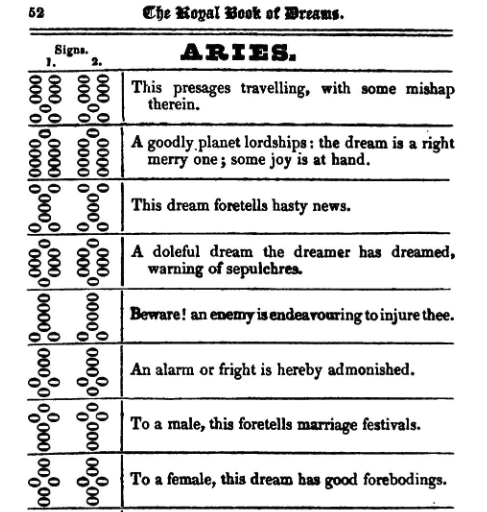The Royal Book of Dreams
The Royal Book of Dreams is a dream interpretation book written by Robert Cross Smith and first published in 1830. The book provides methods for analyzing dreams and methods of Oneiromancy (foretelling the future through dreams).
Full title
The title of the original manuscript was The Regal boke of Dreemes: a merbellous and faythefull Expounder of Nyghte Visiones.
Robert Cross Smith's florid, Victorian title for the published book was: Royal Book Of Dreams: From an Ancient and Curious Manuscript, which Was Buried in the Earth During Several Centuries, Containing One-thousand & Twenty-four Oracles, or Answers to Dreams By a Curious, Yet Perfectly Facile and Easy Method, Void of All Abstruse or Difficult Calculations; Whereby Any Person of Ordinary Capacity May Discover Those Secrets of Fate, Which the Universal Fiat of All Nations, In Every Age and Clime, Has Acknowledged to be Portended By Dreams and Nocturnal Visions.
Manuscript
The book's author, Robert Cross Smith, opens the text with an introduction describing the circumstances in which he discovered the manuscript of the book. His story involved a trip to Somerset where, in the vicinity of Bristol, he visited a ruined manor house. While at the house, he was shown a manuscript from the 1500s that was found during an excavation of the Catholic chapel attached to the manor. The manuscript was contained inside a crumbling wooden box with a crucifix. Upon realizing the book's importance as a spiritual tool, Smith quickly purchased it and began transcribing it into modern English.
Content
The book uses a complex series of ciphers combined with astrology to give indications of what a dream might mean as well as what it portends for the future. At the end of the book, there is a chapter on geomancy completely unrelated to dream interpretation.
Publication
The first published edition was 161 pages. It was published in London by Orlando Hodgson. Surviving copies of the first hardcover edition are considered rare.
